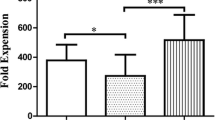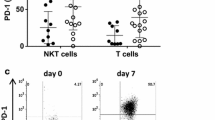Summary
The present study investigated the role of antigen-presenting cells (APC) in the activation of noncytolytic T cells against tumor antigens. The noncytolytic-type T cells exerted their antitumor effect by producing γ-interferon (IFN-γ) and by activating macrophages as the ultimate effectors. The production of IFN-γ by these noncytolytic T cells following the stimulation with tumor cells required the participation of Ia+ APC, since the depletion of APC from cultures of tumor-immunized spleen cells resulted in almost complete inhibition of the IFN-γ production. Both L3T4+ and Lyt-2+ subsets of T cells were capable of producing IFN-γ, and the requirement of APC for the production of IFN-γ was the case irrespective of whether noncytolytic T cells were of L3T4+ or Lyt-2+ phenotype. More importantly, it was demonstrated that the production of IFN-γ by L3T4+ and Lyt-2+ T cells was inhibited by addition of the respective anti-class II and anti-class I H-2 antibody to cultures. These results indicate that antitumor L3T4+ or Lyt-2+ noncytolytic T cells are activated for the IFN-γ production by recognizing tumor antigens in the context of self-class II or -class I H-2 molecules on APC.
Similar content being viewed by others
References
Dalman MJ, Mason DW (1983) Cellular mechanisms of skin allograft rejection in the rat. Transplant Proc 15:335
Dialynas DP, Quan ZS, Wall KA, Pierres A, Quintans J, Loken MR, Pierres M, Fitch FW (1983) Characterization of the murine T cell surface molecule, designated L3T4, identified by monoclonal antibody GK-1.5: similarity of L3T4 to the human Leu-3/T4 molecule. J. Immunol 131:2445
Dialynas DP, Wilde DB, Marrack P, Pierres A, Wall KA, Havran W, Otten G, Loken MR, Pierres M, Kapler J, Fitch FW (1983) Characterization of the murine antigenic determinant, designated L3T4a, recognized by monoclonal antibody GK1.5: Expression of L3T4a, by functional T cell clones appears to correlate primarily with class II MHC antigen reactivity. Immunol Rev 74:29
Fernandes-Cruz E, Woda BA, Feldman JD (1980) Elimination of syngeneic sarcomas in rats by a subset of T lymphocytes. J Exp Med 152:823
Fujiwara H, Hamaoka T, Teshima K, Aoki H, Kitagawa M (1976) Preferential generation of killer or helper T-lymphocyte activity directed to the tumor-associated transplantation antigens. Immunology 31:239
Fujiwara H, Fukuzawa M, Yoshioka T, Nakajima H, Hamaoka T (1984) The role of tumor-specific Lyt-1+2− T cells in eradicating tumor cells in vivo. I. Lyt-1+2− T cells do not necessarily require recruitment of host's cytotoxic T cell precursors for implementation of in vivo immunity. J Immunol 133:1671
Fujiwara H, Takai Y, Sakamoto K, Hamaoka T (1985) The mechanism of tumor growth inhibition by tumor-specific Lyt-1+2− T cells. I. Antitumor effect of Lyt-1+2− T cells depends on the existence of adherent cells. J Immunol 135:2187
Fukuzawa M, Fujiwara H, Yoshioka T, Itoh K, Hamaoka T (1985) Tumor-specific Lyt-1+2− T cells can reject tumor cells in vivo without inducing cytotoxic T lymphocyte responses. Transplant Proc 17:599
Glimcher LH, Longo DL, Green I, Schwartz RH (1981) Murine syngeneic mixed lymphocyte response. I. Target antigens are self Ia molecules. J Exp Med 154:1652
Gray PW, Goeddel DV (1983) Cloning and expression of murine immune interferon cDNA. Proc Natl Acad Sci USA 80:5842
Greenberg PD, Cheever MA, Fefer A (1982) Eradication of disseminated murine leukemia by chemoimmunotherapy with cyclophosphamide and adoptively transferred immune syngeneic Lyt-1+2− lymphocytes. J Exp Med 154:952
Julius MH, Simpson E, Herzenberg LA (1973) A rapid method for the isolation of functional thymus-derived murine lymphocytes. Eur J Immunol 3:645
Kern DE, Klarnet JP, Jensen MCV, Greenberg PD (1986) Requirement for recognition of class II molecules processed tumor antigen for optimal generation of syngeneic tumor-specific class I-restricted CTL. J Immunol 136:4303
Kosugi A, Yoshioka T, Suda T, Sano H, Takahama Y, Fujiwara H, Hamaoka T (1987) The activation of L3T4+ helper T cells assisting the generation of anti-tumor Lyt-2+ cytotoxic T lymphocytes: Requirement of Ia-positive antigen-presenting cells for processing and presentation of tumor antigens. J Leucocyte Biol 42:632
LeFrancois L, Bevan MJ (1984) A reexamination of the role of Lyt-2-positive T cells in murine skin graft rejection. J Exp Med 159:57
Leveland BE, Hogarth PM, Geredig RH, Mekenzie IFC (1981) Cells mediating graft rejection in the mouse. I. Lyt-1 cells mediate skin graft rejection. J Exp Med 153:1044
Lowry RP, Gurley KE, Blackburn J, Forbes RDC (1983) Delayed type hypersensitivity and lymphocytotoxicity in cardiac allograft rejection. Transplant Proc 15:343
Mizuochi T, Golding H, Rosenberg AS, Glimcher LH, Malek TR, Singer A (1985) Both L3T4+ and Lyt-2+ helper T cells initiate cytotoxic T lymphocyte responses against allogeneic major histocompatibility antigens but not against trinitrophenyl-modified self. J Exp Med 162:427
Nakjima H, Fujiwara H, Takai Y, Izumi Y, Sano S, Tsuchida T, Hamaoka T (1985) Studies on macrophage-activating factor (MAF) in anti-tumor immune responses. I. Tumor specific Lyt-1+2− T cells are required for producing MAF able to generate cytolytic as well as cytostatic macrophages. J Immunol 135:2199
Nakajima H, Izumi Y, Sugihara S, Satoh Y, Isumi S, Gotoh T, Fujiwara H, Hamaoka T (1987) Studies on macrophage-activating factor (MAF) in antitumor immune responses. II. Molecular characterization of MAF produced by tumor-immune Lyt-1+2− T cell subset. Cancer Immunol Immunother 25:201
Oi VT, Jones PP, Goding JW, Herzenberg LA, Herzenberg LA (1978) Properties of monclonal antibodies to mouse Ig allotype, H-2, and Ia antigens. Curr Top Microbiol Immunol 81:115
Ozato K, Mayer N, Sachs DH (1980) Hybridoma cell lines secreting monoclonal antibodies to mouse H-2 and Ia antigens. J Immonul 124:533
Rosenberg AS, Mizuochi T, Singer A (1986) Analysis of T-cell subsets in rejection of Kb mutant skin allografts differing at class I MHC. Nature 322:829
Rosenberg AS, Mizuochi T, Sharrow SO, Singer A (1987) Phenotype, specificity, and function of T cell subsets and T cell interactions involved in skin allograft rejection. J Exp Med 165:1296
Sakamoto K, Fujiwara H, Nakajima H, Yoshioka T, Takai Y, Hamaoka T (1986) The mechanism of tumor growth inhibition of tumor-specific Lyt-1+2− T cells. II. Requirements of adherent cells for activating Lyt-1+2− T cells as well as for functioning as anti-tumor effector activated by factor(s) from Lyt-1+2− T cells. Jpn J Cancer Res (Gann) 77:1142
Sakamoto K, Yoshioka T, Shimizu J, Sato S, Fujiwara H, Hamaoka T (1988) Role of tumor-specific Lyt-2+ T cells in tumor growth inhibition in vivo. II. Mechanisms for recognition of tumor antigens and mediation of anti-tumor effect by non-cytolytic Lyt-2+ T cell subset. Jpn J Cancer Res (Gann) 79:99
Singer A, Kruisbeek AM, Andrysiak PM (1984) T cell-accessory cell interactions that initiate allospecific cytotoxic T lymphocyte responses: Existence of both Ia-restricted and Ia-unrestricted cellular interaction pathways. J Immunol 132:2199
Sprent J, Schaefer M (1985) Properties of purified T cell subsets. I. In vitro responses to class I vs. class II H-2 alloantigens. J Exp Med 162:2068
Swain SL, Panfili PR (1979) Helper cells activated by allogeneic H-2K or H-2D differences have Ly phenotype distinct from those responsive to I differences. J Immunol 122:383
Tilney NL, Kipiec-Weglinshi JN, Heidecke CD, Lear PA, Storm TB (1984) Mechanisms of rejection and prolongation of vascularized organ allografts. Immunol Rev 77:185
Yoshioka T, Sato S, Ogata M, Sano H, Shima J, Yamamoto H, Fujiwara H, Hamaoka T (1988) Role of tumor-specific Lyt-2+ T cells in tumor growth inhibition in vivo. I. Mediation of in vivo tumor-neutralizing activity by Lyt-2+ as well as L3T4+ T cell subsets. Jpn J Cancer Res (Gann) 79:91
Author information
Authors and Affiliations
Additional information
This work was supported by a Grant-in-Aid for the Special Project Cancer-Bioscience from the Ministry of Education, Science and Culture, Japan
Rights and permissions
About this article
Cite this article
Sakamoto, K., Nakajima, H., Shimizu, J. et al. The mode of recognition of tumor antigens by noncytolytic-type antitumor T cells: Role of antigen-presenting cells and their surface class I and class II H-2 molecules. Cancer Immunol Immunother 27, 261–266 (1988). https://doi.org/10.1007/BF00205449
Received:
Accepted:
Issue Date:
DOI: https://doi.org/10.1007/BF00205449




